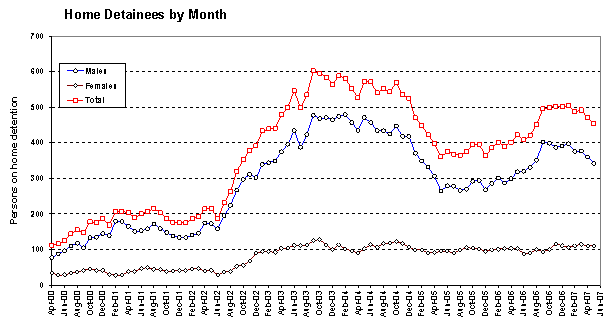Background and overview
Abstract
A clear disparity has been identified between Maori and New Zealand European offenders with respect to both “leave to apply” for Home Detention, and approval of applications to the Parole Board.. A statistically-based analysis was undertaken to investigate possible reasons for this disparity. This indicated that Maori offenders potentially eligible for Home Detention tended to present with more extensive offending histories, including failure to comply with previous sentences and orders. Such characteristics largely (though not entirely) explained the lower rates with which Maori obtained access to Home Detention.
Background and overview
In 2006 the Department of Corrections was directed by the Government to investigate the use of Home Detention with respect to differences in the rate at which it was applied to Maori and Pacific peoples. This paper reports on the resulting study, which used data from Home Detention cases in 2005. It examines ethnicity-based differences in offenders obtaining Leave to Apply for Home Detention, offenders’ subsequent applications, the approval of such applications by the Parole Board and, finally, the extent to which orders were breached.
From initial review of the raw data, Maori appear disadvantaged, relative to New Zealand Europeans, with respect to Home Detention decisions. Maori are less likely to obtain Leave to Apply and, amongst those who do, are less likely to be granted approval. Disparities of this scale were not apparent for Pacific offenders. This report largely deals with exploring possible reasons for the observed differences between Maori and New Zealand European offenders. Data were analysed with reference to a number of potential explanatory factors.
The Home Detention decision-making process
The Sentencing Act 2002 and the Parole Act 2002 provided for offenders to serve a custodial sentence under Home Detention conditions as a result of a two-step process. Firstly, an offender had to be granted Leave to Apply by the judge at time of sentencing. The Sentencing Act 2002 set out the factors which judges were to take into account when granting such leave. Those were the nature and seriousness of the offence, the circumstances and background of the offender, and any matters in the victim impact statement which may be relevant to the appropriateness of Home Detention.
Secondly, offenders who obtained Leave to Apply were required to submit formal applications (usually from within prison) to the Parole Board, who then determined whether an offender was suitable for release under the conditions of Home Detention. The application and approval process was governed by the Parole Act of 2002. Once an application was received the Board sought a report from the Community Probation Service; these reports comprised an assessment of the suitability of the proposed residence, risk of re-offending, likelihood of the offender complying with the restrictions inherent to Home Detention, suitability for rehabilitation, and (if required) views of victims. The probation officer also ensured occupants of the proposed residence were aware of the applicant’s background, nature of their offending, and other relevant information.
Trends in numbers of offenders subject to Home Detention orders
Numbers of offenders on Home Detention orders (both front- and back-end) fluctuated since the order was introduced in October 1999. A plateau of around 600 was reached in October 2004, but numbers dropped sharply to reach a low of 360 in August 2005. Following December 2005 Cabinet decisions concerning Home Detention and electronic monitoring on bail, numbers began once more to climb. However, the muster then fell again by June 2007, at which point it sat at around 450.
Figure 1: Monthly totals of offenders on Home Detention, by month (April 2000 - June 2007)

Despite constituting around 50% of all offenders potentially eligible for Home Detention at the sentencing stage, Maori made up under 40% of the Home Detention muster at any given point in time (see Appendix 2). Clearly then, processes were operating that had the effect of reducing Maori offenders’ chances of serving the imposed sentence under Home Detention conditions. The current paper reports on an attempt to understand the reasons for this finding.
The purpose of this analysis was to explain any disparities found between ethnic groups in the rates of their being granted Leave to Apply, approval to serve the sentence on Home Detention, and so on. Depending on the nature of the differences and conclusions on their causes, it was hoped that potential policy or practice changes might then emerge which could improve outcomes for Maori.

